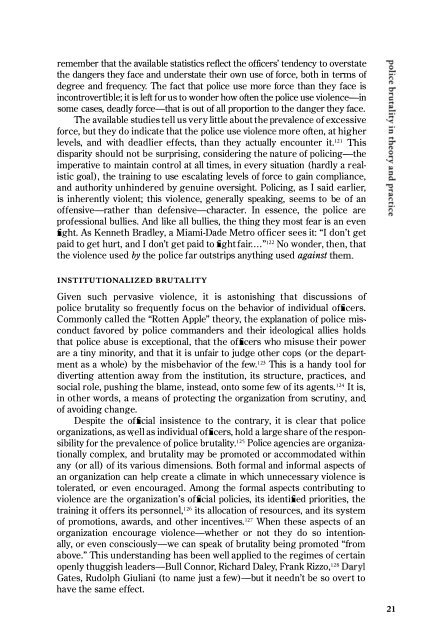Kristian Williams - Our Enemies in Blue - Police and Power in America
Kristian Williams - Our Enemies in Blue - Police and Power in America
Kristian Williams - Our Enemies in Blue - Police and Power in America
You also want an ePaper? Increase the reach of your titles
YUMPU automatically turns print PDFs into web optimized ePapers that Google loves.
emember that the available statistics reflect the officers' tendency to overstatethe dangers they face <strong>and</strong> understate their own use of force, both <strong>in</strong> terms ofdegree <strong>and</strong> frequency. The fact that police use more force than they face is<strong>in</strong>controvertible; it is left for us to wonder how often the police use violence-<strong>in</strong>some cases, deadly force-that is out of all proportion to the danger they face.The available studies tell us very little about the prevalence of excessiveforce, but they do <strong>in</strong>dicate that the police use violence more often, at higherlevels, <strong>and</strong> with deadlier effects, than they actually encounter it.121 Thisdisparity should not be surpris<strong>in</strong>g, consider<strong>in</strong>g the nature of polic<strong>in</strong>g-theimperative to ma<strong>in</strong>ta<strong>in</strong> control at all times, <strong>in</strong> every situation (hardly a realisticgoal) , the tra<strong>in</strong><strong>in</strong>g to use escalat<strong>in</strong>g levels of force to ga<strong>in</strong> compliance,<strong>and</strong> authority unh<strong>in</strong>dered by genu<strong>in</strong>e oversight. Polic<strong>in</strong>g, as 1 said earlier,is <strong>in</strong>herently violent; this violence, generally speak<strong>in</strong>g, seems to be of anoffensive-rather than defensive-character. In essence, the police areprofessional bullies. And like all bullies, the th<strong>in</strong>g they most fear is an evenfight. As Kenneth Bradley, a Miami-Dade Metro officer sees it: "I don't getpaid to get hurt, <strong>and</strong> I don't get paid to fight fair ...."122 No wonder, then, thatthe violence used by the police far outstrips anyth<strong>in</strong>g used aga<strong>in</strong>st them.INSTITUTIONALIZED BRUTALITYGiven such pervasive violence, it is astonish<strong>in</strong>g that discussions ofpolice brutality so frequently focus on the behavior of <strong>in</strong>dividual officers.Commonly called the "Rotten Apple" theory, the explanation of police misconductfavored by police comm<strong>and</strong>ers <strong>and</strong> their ideological allies holdsthat police abuse is exceptional, that the officers who misuse their powerare a t<strong>in</strong>y m<strong>in</strong>ority, <strong>and</strong> that it is unfair to judge other cops (or the departmentas a whole) by the misbehavior of the few. 123 This is a h<strong>and</strong>y tool fordivert<strong>in</strong>g attention away from the <strong>in</strong>stitution, its structure, practices, <strong>and</strong>social role, push<strong>in</strong>g the blame, <strong>in</strong>stead, onto some few of its agents.124 It is,<strong>in</strong> other words, a means of protect<strong>in</strong>g the organization from scrut<strong>in</strong>y, <strong>and</strong>of avoid<strong>in</strong>g change.Despite the official <strong>in</strong>sistence to the contrary, it is clear that policeorganizations, as well as <strong>in</strong>dividual officers, hold a large share of the responsibilityfor the prevalence of police brutality. 12> <strong>Police</strong> agencies are organizationallycomplex, <strong>and</strong> brutality may be promoted or accommodated with<strong>in</strong>any (or all) of its various dimensions. Both formal <strong>and</strong> <strong>in</strong>formal aspects ofan organization can help create a climate <strong>in</strong> which unnecessary violence istolerated, or even encouraged. Among the formal aspects contribut<strong>in</strong>g toviolence are the organization's official policies, its identified priorities, thetra<strong>in</strong><strong>in</strong>g it offers its personnel,126 its allocation of resources, <strong>and</strong> its systemof promotions, awards, <strong>and</strong> other <strong>in</strong>centives. I27 When these aspects of anorganization encourage violence-whether or not they do so <strong>in</strong>tentionally,or even consciously-we can speak of brutality be<strong>in</strong>g promoted "fromabove." This underst<strong>and</strong><strong>in</strong>g has been well applied to the regimes of certa<strong>in</strong>openly thuggish leaders-Bull Connor, Richard Daley, Frank Rizzo,128 DarylGates, Rudolph Giuliani (to name just a few)-but it needn't be so overt tohave the same effect.21


